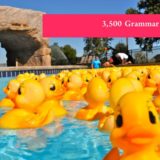Assessment and ESL: An Alternative Approach [Excerpt]
This excerpt is taken from Assessment and ESL: An Alternative Approach and in many ways reflects the philosophy of the All English language program, but from the viewpoint of assessment.
THE FOUR THEMES
In our first book, The More Than Just Surviving Handbook, we discussed the process of learning another language effectively around four basic themes:
- Real language
- Integrated and whole language
- A facilitating environment
- Learning is a continuum, in which errors have a place and role
We can also discuss assessment within the framework of these four themes.
Real Language
This refers to language that has purpose, that is meaningful, authentic, and relevant. The reasons students have for using language must be more than simply to please the teacher and get a good grade. Students have many reasons for using real language: to order food, to ask a parent for an allowance, to convince the teacher to give them an extra day for completing an assignment, to tell a joke to a friend, and so on.
In the same vein, the language in which a student is being assessed must also have meaning and purpose. Th e context must be the type of situation he encounters in everyday life, rather than contrived language used to illustrate a phonic principle or language someone has decided is “easy.” Research shows that students often perform more poorly on tasks that are dull, uninteresting, meaningless, purposeless, boring, or frustrating than they do on tasks that have a purpose (Smith, 1998). When the student cannot see a purpose for what he is doing or, if the cost of trying is too high compared to his expected rate of success, he may not give the task the time, attention, or effort it requires. Forester and Reinhard (1989) write:
Evaluation of children’s reading and writing should take place while they are actually reading and writing and not in situations that are supposed to simulate reading and writing. This makes it possible for the teacher to learn about how children use the many resources that are available to them from their classmates and from print material.
Real assessment, then,
- is realistic. Tasks being assessed closely follow the ways in which our ability is tested in the real world
- requires judgment and innovation on the part of the student
- measures the progress of students engaged in authentic tasks
- involves tasks that have meaning for the student
- is dynamic and flexible. It can vary in time, context and demands
- uses multiple means of measuring knowledge and skills
Integrated and Whole Language
For many years it was thought that language and literacy skills equaled the sum of their parts, that teaching the parts would lead to adequate understanding of the whole, and that testing the parts would give us insight into a student’s grasp of the whole. We now know this is not true. Davies et al. (1992) write that “language is not a set of unrelated bits. It forms a whole…the bits must be integrated and tested in combination with one another.” Assessment tools do not fragment language. They do not measure just spelling, or grammar, or word lists, or comma splices; they measure language use as a whole. Shuy (1973) writes:
Tests of grammar and phonology are not accurate predictors of effective participation… functional language competence is far more crucial. That is, a child’s ability to seek clarification or get a turn seems much more critical than his ability to use past-tense markers.
In The Primary Language Record: Handbook for Teachers, Barrs et al. (1989) state that “reading cannot be examined in total isolation from talking, listening and writing, so it is important to consider each child in the context of her/his language and learning experiences.” As well, language is assessed within the context of the surrounding environment, not divorced from it.
According to Gumperz (1964):
Context is thought of as the physical setting, the people within the setting, what the people are doing and saying, and where and when they are doing it. Language is embedded in the flow of daily life.
Assessment, then, does not isolate one skill from another. Reading is not separate from writing, listening, and speaking. What a student says about what he writes is important. His comments about what he has read reveal much about what he has understood. The drawings that illustrate what he wrote, and the actions he pantomimes to explain a situation are all clues to competence.
Integrated assessment, then, means
- the context of the situation is as significant as the task itself
- tasks consist of more than just rote memorization
- individual tasks are not isolated from other people or from other skills
A Facilitating Environment
The learning environment must be conducive to learning. A facilitating environment means several things. First, it means a positive orientation on the part of the teacher and classmates that allows a learner to behave naturally and feel truly capable of expressing himself openly without fear of ridicule or punishment. Second, the environment and, consequently, assessment, should focus on positive achievement rather than on negative failure. Too much testing can be punitive, focusing on errors and a student’s failure to measure up to a standard. According to Murphy (1992), emphasis should be on “meaningful and positive descriptions of what pupils know, understand, and can do.” Facilitative assessment, then,
- is constructive, not destructive
- recognizes the student’s achievements, not his failures
- treats the student as a person worthy of respect, not a number
- gives the student a chance to experience success in a wide variety of contexts at many different levels
- provides a continuous record of tasks and stages of achievement that the student demonstrates
- takes into consideration students’ learning styles, language proficiencies, cultural and educational backgrounds, and grade levels of students
Learning Is a Continuum
Forester and Reinhard (1989) speak of learning as a journey: it is not enough to note that students are giving correct answers on exercise sheets, reading well orally, copying words correctly, or spelling words from a list correctly. The question is, can they readily transfer that knowledge to new and different situations? Or, do they simply know it at the imitation or product level? Observing students’ small steps forward will tell you far more about who has truly internalized knowledge and where individual students are along the learning continuum.
Every student travels along the learning continuum at his own pace. Although Nok and Veapasert are both ten and arrived in their new country at the same time, that does not mean we should expect them to be at the same level of proficiency. We cannot be concerned that it takes one longer to get there than it takes the other. We cannot judge developing English students according to a preset timeline, considering them failures or disabled because they do not achieve competence as quickly as we would like. For example, when Isabella says, “Tengo toys” (tengo is Spanish for “I have”), she is demonstrating progress. She is making the transition from monolingual Spanish to English, a piece at a time.
This also means that errors are not necessarily indication of a problem. Errors do not denote failure to learn. According to Goodman (1988):
Errors, miscues, or misconceptions usually indicate ways in which a child is organizing the world at that moment… Errors also indicate interpretations which may in no way be wrong, but simply show that the child has used inferences about reading or listening which were unexpected… the [observer] who understands the role of unexpected responses will use children’s errors or miscues to chart their growth and development and to understand the personal and cultural history of the child. Often errors signal the onset of leaps in knowledge, as, for instance, the explosion of invented spelling with children just on the verge of putting reading together. Teachers who are familiar with the bumps and quirks of language and literacy learning encourage approximations and invented spellings with the faith and certainty that, over time and with continued exposure to the desired and ideal forms, children will learn them.
Teachers of ESL students also encourage approximations, sentences that contain both languages and creative grammar, because they know that these features indicate the student is moving forward toward proficiency.
Understanding that learning is a continuum means
- all students are given the time they need, independent of what the policymakers think is a reasonable amount of time for mastering English or what other students are doing
- there is a place for errors
- errors can be considered indicators of progress rather than failure to learn
- errors are roadmaps for teachers, telling us where the student is now and where we need to go next
Source:
Assessment and ESL: An Alternative Approach 2nd Edition
by
Publisher: Portage & Main Press (2007)
ISBN-10: 1553790936
ISBN-13: 978-1553790938













